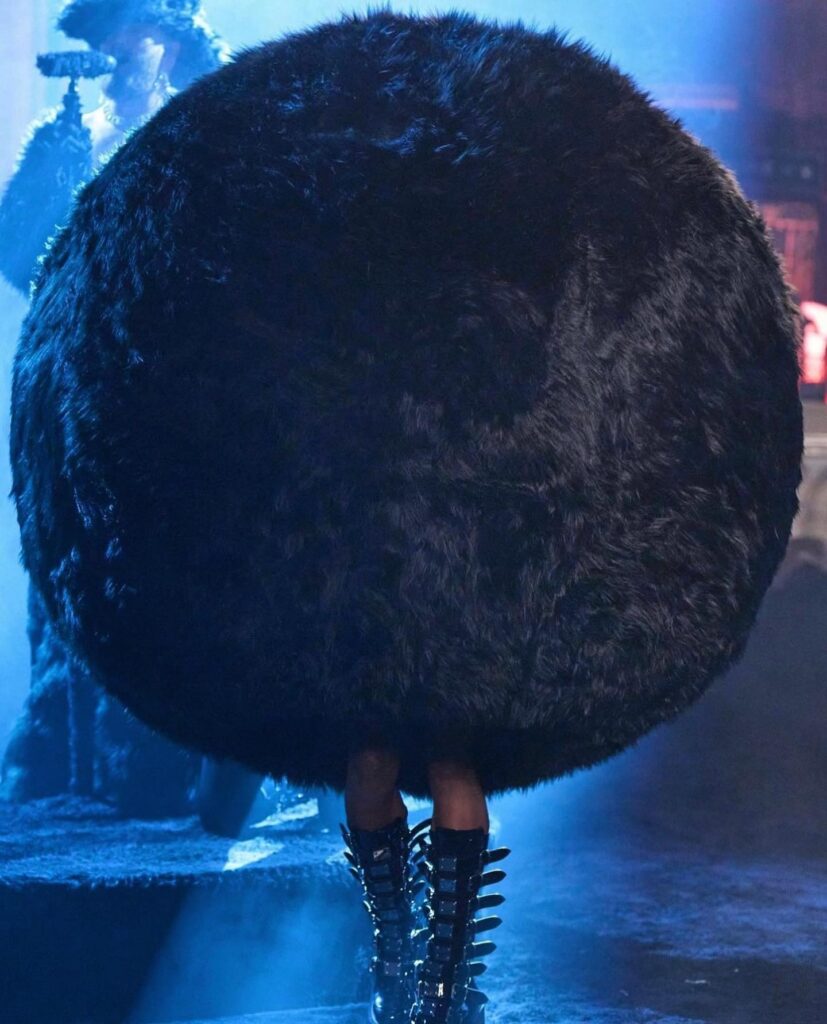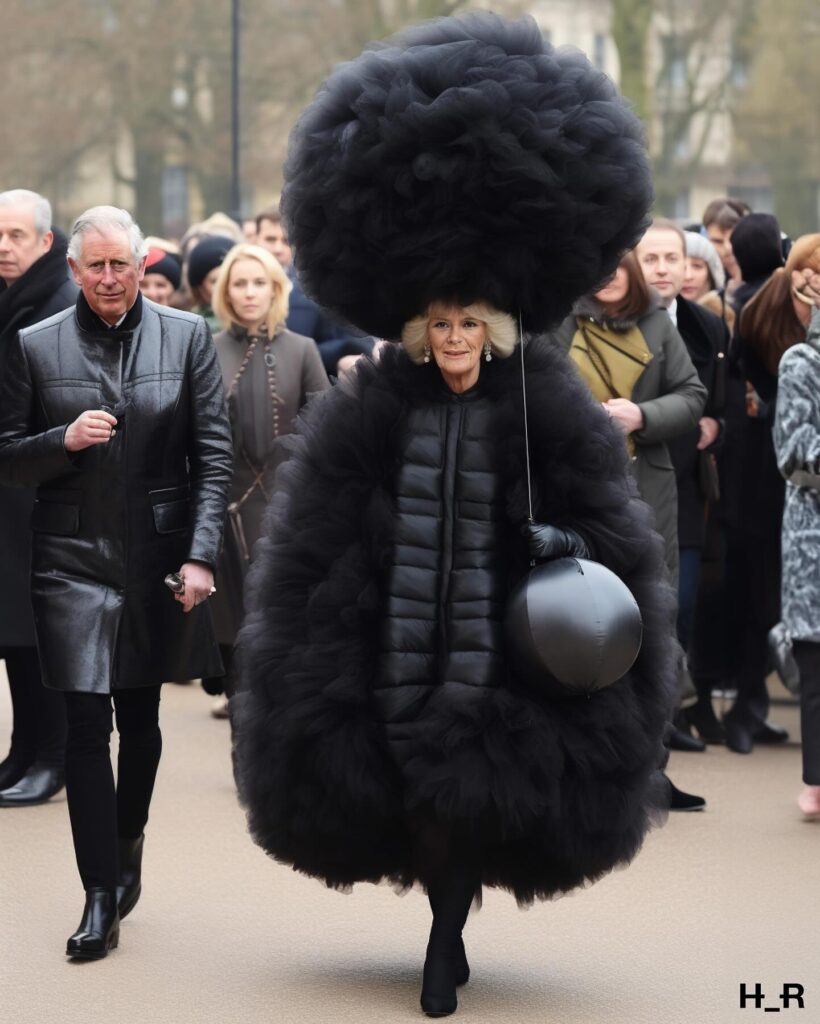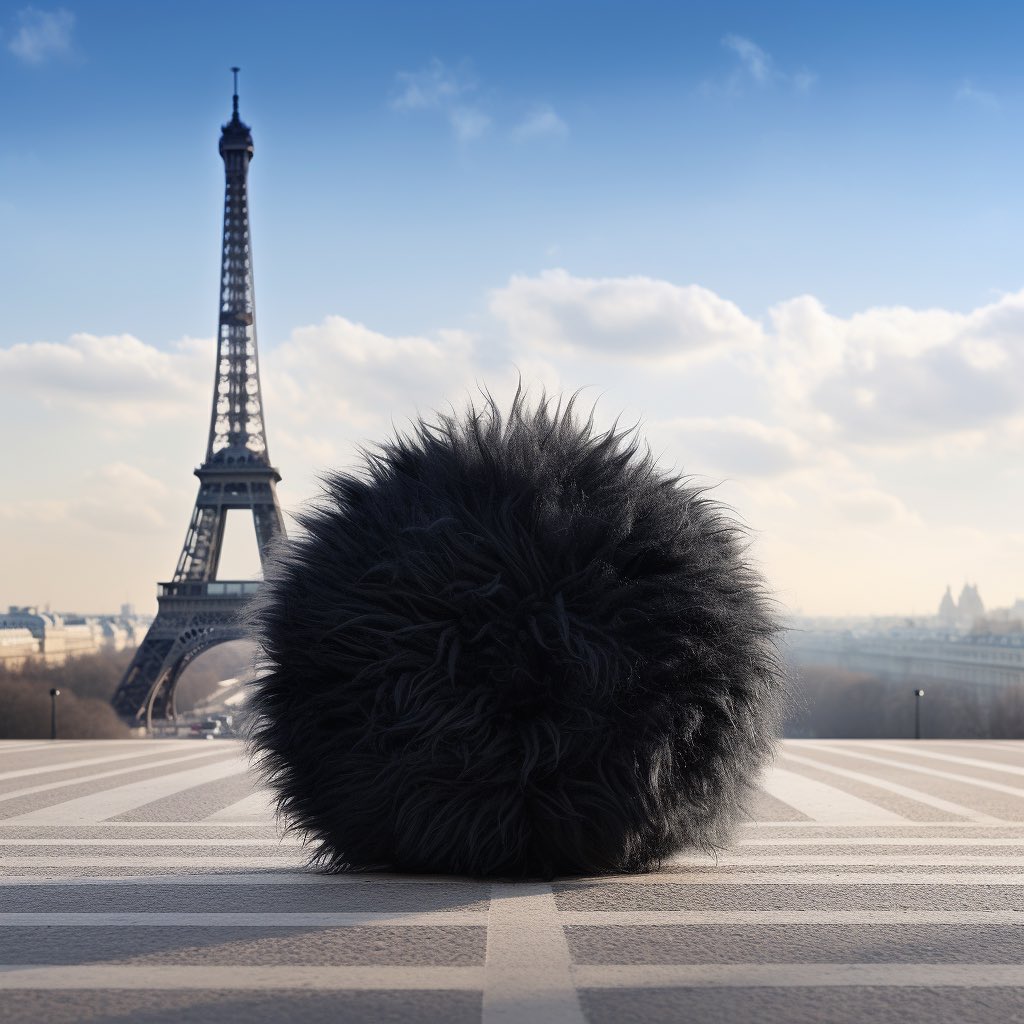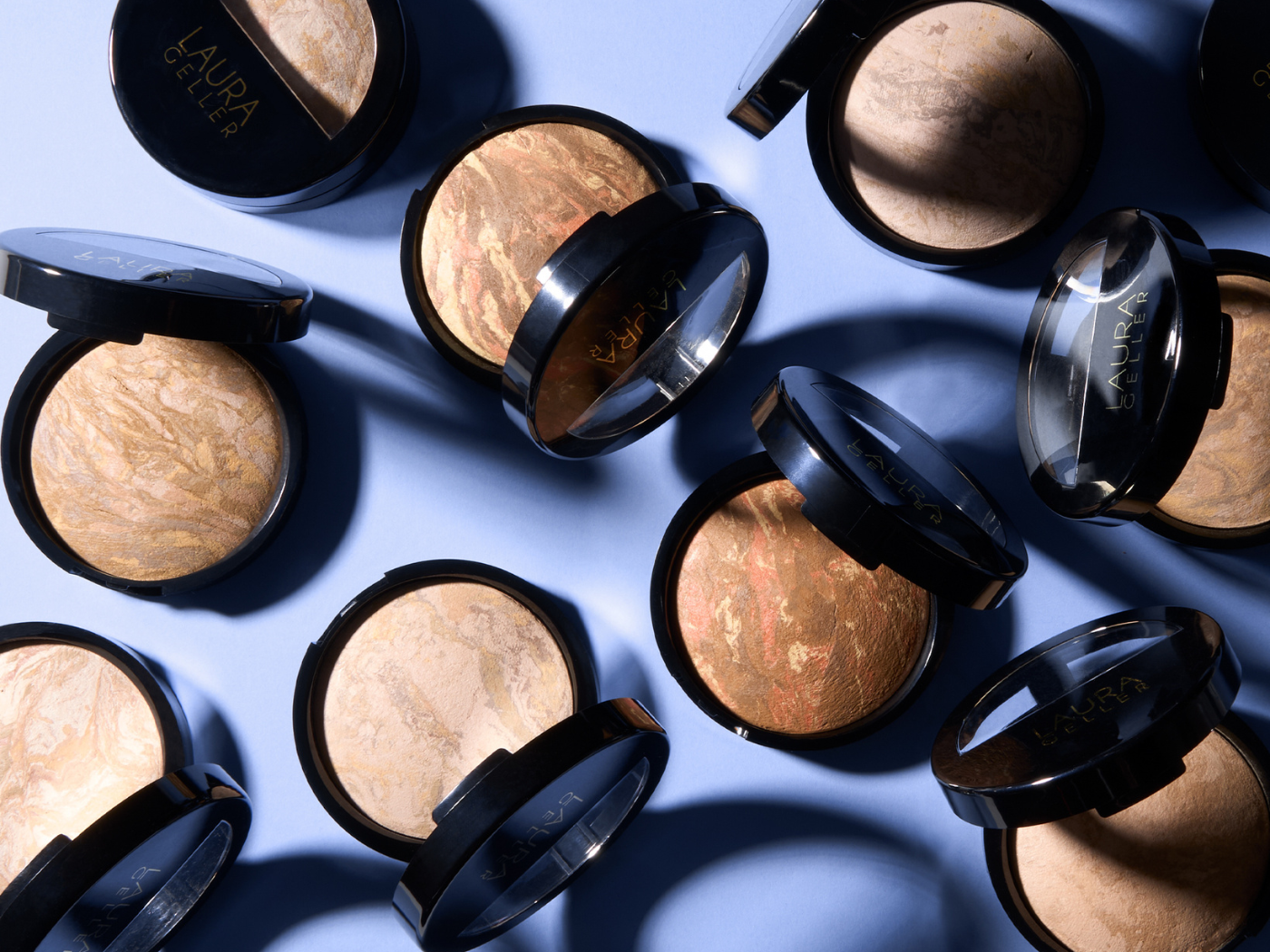From Pamela Anderson’s fresh-faced makeunder to Amanda Lepore’s robotic strut down the runway at Balenciaga, there were plenty of viral moments during Paris Fashion Week this fall. But few quite compared to the unabashed Zoolanderishness of the fur ball who got lost on the Christian Cowan runway.
In what turned out to be a genius feat of guerrilla marketing, French fashion designer Christian Cowan decided to shake things up at his spring show by sending a model down the runway dressed as a giant fur ball. Yes, you heard that correctly: a giant fur ball. Unable to see through the impenetrable fuzzy ball covering her head, the model proceeded to meander aimlessly about the stage, bumping into Cowan’s boyfriend Sam Smith, who was performing during the show, ultimately crashing into the altar of the American Cathedral in which the collection was being staged.

So, what exactly was this dystopian supermodel-meets-furries-with a dash of religious mayhem meant to signify? CEW reached out to Christian Cowan, who seemed delighted with the chaotic turn of events.
“I always want to remind the audience that fashion is not just about immaculate presentation, but it can also be about embracing the unpredictable,” the designer told CEW. “I am constantly exploring ways to push the boundaries of creativity and redefine the conventional norms of the fashion industry. I believe that integrating unexpected elements can infuse my shows with the same sense of energy and excitement I have while creating the pieces. I want to continue to find innovative ways to engage the audience and challenge the traditional notions of fashion shows.”
Fashion as performance art is not exactly a new concept, which might explain why the traditional media present at the time remained nonplussed by the fur ball spectacle, hashtagging #neveradullmoment, before turning a blase eye toward the next show.

The AI community, on the other hand, quickly sprung into action, giving the fur ball major wing span in a series of viral memes. In short order, HRH Camilla Parker Bowles got the fur ball fashion memo, turning up in Paris in a colossal virtual getup courtesy of AI artist @hey_reilly. And wait: was the fur ball “accident” even real? An account called @theIncognitoInfluencerproject reposted a picture from Cowan’s account of a fictionalized fur ball from a few days prior, anticipating its big runway debut as it posed in front of the Eiffel tower in Paris. Was the whole thing one giant publicity stunt with a cast of deep fake supporting players?

The fur ball that launched a thousand memes provides an interesting case study in the power of a new breed of AI Influencers to generate viral content and amplify brand messaging. So, who exactly are these virtual creators and what do beauty brands need to know about this fast moving corner of the social media universe? CEW sat down with Stéphane Galienni (aka, the Incognito Influencer) to discuss the evolution of influencer marketing, the ethical issues surrounding the use of this AI technology, and how brands can tap into this potentially lucrative new pool of creative virtual talent.
CEW: What inspired you to create “The Incognito Influencer Project?”
Incognito Influencer: Balistik Art, the agency I founded with my partner Katja Graisse, has been supporting major luxury brands in their digital creative strategies since 2007. We’re a small, agile structure, highly focused on emerging technologies for the luxury industry. Each September during fashion month, we study runway trends and compile a report for our clients. All this is done behind our screens, from our Paris-based agency. The original concept of the Incognito Influencer was to create a fictional influencer who would “virtually” infiltrate the front rows of Fashion Weeks in New York, London, Milan, and Paris. This new approach to fashion reporting was meant to highlight our capabilities for digital storytelling; to show that we could deliver AI content that mirrors the swift pace of runway events and aligns with the rhythm demanded by social networks.
CEW: And when did the first AI muses emerge?
CG: In 2016, we witnessed the emergence of the first virtual muses brought to life through 3D and CGI (computer-generated imagery) technologies. Figures like Lil Miquela and Noonoori, created through these techniques, have since become bona fide web stars and serve as muses for major luxury and fashion houses.
CEW: I don’t recall seeing AI influencers before this year. When exactly did this start?
CG: In the first half of 2023, we saw the rise of the third generation of AI influencers. And these virtual influencers swiftly amassed hundreds of thousands of followers on platforms like Instagram and TikTok in just a matter of months. For our latest BLSTK study titled, “Luxe Intelligenc.ia,” we identified approximately 30 accounts following this new model. These influencers are primarily located in the United States, Asia (including China and Korea), and to a lesser extent, Europe. Notably, most of them are sexy young women who exhibit beauty and allure, whose photographic realism is more akin to 1.0 influencers (flesh and blood) than 2.0 (3D avatars).
CEW: Can you give us an example of a popular AI influencer? Is there a Kim Kardashian of virtual muses?
SG: A good example of an AI model that is perfectly in tune with the worlds of fashion, luxury, and beauty, and is already amassing promising audiences is @feli.airt. Her account reached 300K in just six months with 13.9M views on TikTok according to her bio.
CEW: For a beauty brand, what are the potential advantages offered by AI influencers?
SG: One of the distinct advantages of this new generation of influencers is that brands can wield complete control over them. Unlike real influencers, they don’t require any expenses to travel, and there will never be any unexpected complications stemming from their whims or adverse publicity. With AI influencers, the image is meticulously crafted as a luxury visual conceived by the designer or artist who operates behind their AI muse.
CEW: How do brands and/or creators create virtual AI models?
CG: Tools like Midjourney or Stable Diffusion allow precise customization of lighting, model poses, overall photogenic aesthetics, and the seamless integration of the brand’s products, all without the need for digital retouching.
CEW: In the age of AI, what does the future of influencer culture look like?
CG: Looking ahead, as AI tools continue to evolve rapidly, it’s conceivable that we will move beyond the mere photographic representation of these AI influencers. Soon, we may witness them in motion (from photo to video), endowed with the ability to speak (via text-to-speech and speech-to-audio technology), and potentially serving as virtual assistants for e-commerce sites or dedicated personal shoppers for major fashion labels.
Following this blueprint, we believe that prominent luxury brands should consider crafting their own AI counterparts to exercise more comprehensive control. This is one of the proposals we aim to present to our clientele, with the “Incognito Influencer” serving as the prototype
CEW: Could you elaborate on the techniques and technologies used to make “Incognito Influencer” appear realistic and engaging to his audience?
SG: Ironically, the greatest challenge lies in creating a distinctive and genuine character, maintaining consistency in identity across various publications—factors such as eye color, hairstyle, morphology in appearance, and personality traits and demeanor in content. Achieving this necessitates a strong command of AI prompts and the application of a few technical stunts. Take, for instance, the case of @sofia.artif’s account, with 125,000 followers on Instagram. In this instance, the young woman embodies more of an old-money feminine archetype and quiet luxury, a trend currently in vogue within the luxury sector and with Gen Z. This portrayal does not revolve around a unique personality like Kate Moss, for example. The face of @sofia.artif exhibits a chameleon-like quality, with followers often drawing comparisons to numerous celebrities, such as Doutzen Kors or Denise Richards, in the comments. It’s likely that the author leverages these celebrity names in their prompts to generate the image of the “ideal woman” or something closely resembling it. This practice underscores the concerns expressed by Hollywood actresses and actors, as their likenesses can be exploited within the AI machinery without regard for image rights, rendering their identities diluted within the AI realm.
For this reason, among others, I decided that my digital counterpart, the “Incognito Influencer,” would be modeled in my own image, from my ID photo. This serves as a tangible method for prompting my audience to reflect upon the concept of digital identity, which has faced significant challenges due to these emerging technologies. In the future, anyone could assume the role of a luxury muse by appropriating the most glamorous faces from across the globe—whether male or female—and assuming the identities of celebrities from the realms of entertainment or politics. Such actions could generate sensationalism in tabloids and on social networks. Even if the victim formally bans the image, the harm is done. Examples like the Pope wearing a Balenciaga down jacket, Donald Trump depicted behind bars, or our French President Macron in a street brawl are among the initial instances of these new “deep fake” technologies that are beginning to proliferate across the internet.
CEW: What ethical considerations do you consider when developing and using AI influencers like “Incognito Influencer”?
SG: In my prompts, I refrain from using names of celebrities, both because I employ my own image and to abstain from contributing to the problematic practices mentioned earlier. I occasionally incorporate cultural or artistic references that resonate with my sensibilities. For instance, I might write something like “very contrasting light, Edward Hooper style” to guide the generation of an image that aligns with the visual I aim to create.
CEW: But isn’t appropriating an artist’s style as ethically dubious as using a model or celebrity’s likeness?
CG: As an art director, I use these cultural references in much the same way as I would when briefing a photographer with creative intentions for a client. On occasion, I may incorporate brand logos, always with a positive intent, as I endeavor to promote the shows that capture my interest without detracting from their integrity.
My objective is to illustrate that harnessing these emerging AI tools has the potential to “generate” emotion, serving as a counterbalance to the divisive discussions surrounding this topic. Given that this content creation is inherently artificial, I believe it’s crucial to offset it with genuine narratives lived through my character. My story incorporates elements of humor, a little discerning perspective on fashion, and the awe of luxury. It remains authentic and unfiltered because it’s very close to my work as an artist or author-narrator.
CEW: How do you differentiate between a digital identity and a deep fake?
SG: As stated above, we need to draw a line between a “deep fake” that usurps the identity of others (celebrities, heads of state, etc.) and an AI-enhanced “selfie” that allows me to create my own digital clone, which affects only myself. When I launched this “Incognito Influencer” concept, I was very explicit with my Linkedin and Instagram communities. However, consider for a moment the possibility that, armed with this expertise, I could have potentially misused it to fabricate deceptive images derived from a rival ex-girlfriend’s or an agency director’s mugshot, with malicious intent. Regrettably, the AI tool in the hands of anonymous Internet users promises the best and the worst. The hyper-realism of such content can serve as “proof in the pudding” for politicized, conspiratorial influencers or other malevolent minds looking to capitalize on these new technologies.
CEW: What do you think is the biggest challenge posed by AI technology?
SG: I believe one of the most significant challenges lies in confronting artificial technology with human emotion, which is missing from AI tools. In the last century, as innovations emerged enabling the replication of reality through mediums like photography and cinematography, Charles Baudelaire and renowned painters protested, calling it unfair competition with ancestral art of manual craftsmanship, the artist’s gesture.
However, hasn’t this technological disruption empowered avant-garde artists to reinvent themselves? Impressionism, Cubism, Surrealism, and all the aesthetic movements stemming from modern and contemporary art have liberated painters from their previous conventional role: meticulously reproducing reality as a documentary or an idealized portrayal for the glorification of Gods, princesses, kings, or the construction of a politically ideal society. And what about advertising propaganda? Its roots trace back to the hieroglyphs of Ramses II, chiseled into stone, where the depicted exploits were, in essence, fabrications intended to establish influential authority over his people.
Authenticity and transparency, as Marcel Duchamp, the originator of Ready Made, once noted, will always be subject to interpretation by “the observer.”
CEW: As an artist, what do you hope viewers take away from the Incognito Influencer?
SG: The “Incognito Influencer Project” examines the dichotomy between anonymity and celebrity. It combines a “photogenic” reality with a “romanticized” fiction, exploring the tension between the façade of fashion versus the genuine essence of the designer and the brand they represent. Superficiality, or rather, the artful intelligence of artifice, is an attitude embraced by fashion influencers, reality TV stars, and social media personalities, much like the major luxury labels that adapt to the inherently profitable game of audience engagement.
Hence, it is imperative that these AI influencers can consistently embody brands without superficiality, while maintaining a distinctive perspective, attitude, and captivating personality—a blend of storytelling elements I have endeavored to establish for the launch of the Incognito Influencer initiative.
CEW: In your opinion, what does the future hold for AI-driven influencer marketing, and how might it impact the traditional fashion industry?
SG: Setting aside any ethical concerns on the matter, let’s provide an overview of the AI-driven influencer landscape in both the US and Asian markets.
We have the case of Caryn Marjorie, a digital replica of a 23-year-old Snapchat influencer with 98% male fan base who has launched her digital clone CarynAI, charging $1 a minute to converse with her as if she were your girlfriend (ndlr: what could go wrong?). She says she managed to earn $100K in her first week and anticipates she can earn about $5 million a month. In Korea, Pulse9 has launched a series of AI avatars such as Zaein as ambassadors for fashion and luxury. In China, celebrity influencers employ their digital clones to autonomously conduct round-the-clock live shopping sales.
These instances represent just the initial examples, yet they vividly illustrate the marketing possibilities presented by these emerging AI technologies for brands within the luxury, beauty, and fashion sectors.
Ultimately, it’s crucial to keep in mind that the human face, its demeanor, and its perspective, even when virtual, can entirely overshadow the technology supporting it. A mere face has the capacity to create the illusion of an emotional connection, a concept we observe daily through the emoticons we use in our emails, text messages, and social media interactions. What if, in the future, your emotions were conveyed not through emojis but via AI-generated selfies? Whether it’s making a compelling impression with your CV photo, attracting attention on Tinder, or presenting your best professional image on LinkedIn, your virtual clone appears to have a promising future. However, the question remains: Are you prepared to merge this clone with your authentic self without disappointing your real-life connections.




